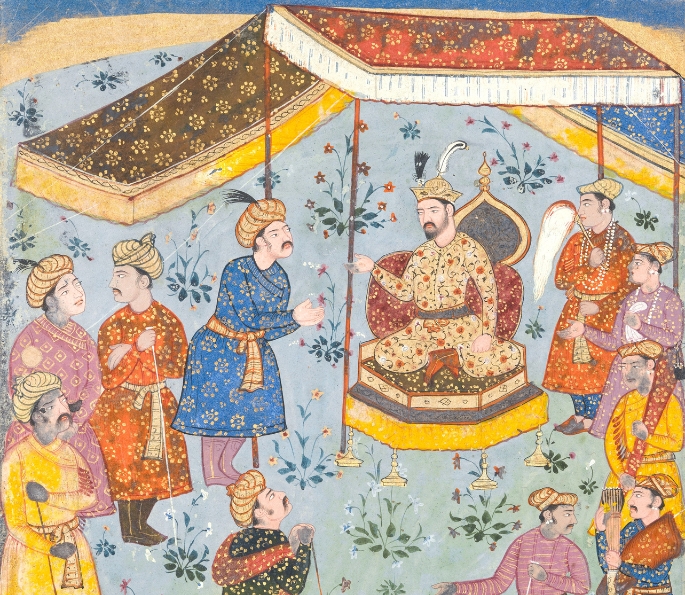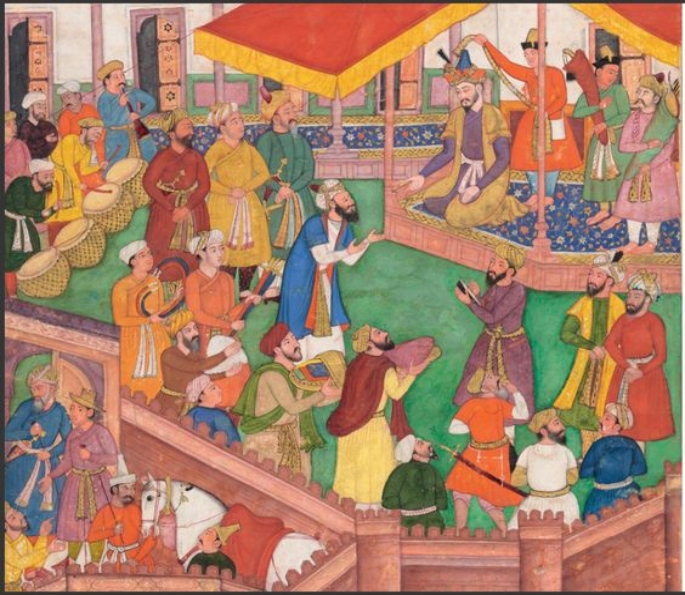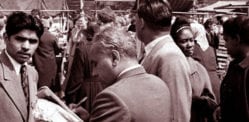This extravagant version stands out from other adaptations.
Imtiaz Ali Taj’s play ‘Anarkali’ is set in Lahore in the 1600s, a time when the influence of the Mughals significantly inspired trade, transport, and architecture.
To gain an understanding of the characters, context, and historical background, we delve into aspects of the play that warrant further investigation.
We uncover accounts from William Finch to provide a first-hand resource that suggests the lifestyle and environment of Lahore in the 1600s.
Moreover, to understand the characters better, we delve into the history of the Mughals and paint a picture of the society in which they lived.
In addition, we gain insight into the lifestyle of the emperors mentioned in the play.
There have been many adaptations, serving as a testament to this legendary story.
Yet, there is a discrepancy regarding the story’s authenticity.
According to The Times of India: “Historians believe that Anarkali might be a fictional character or a composite of multiple individuals.
“Others contend that while the exact details of her life might be obscured by time and embellishment, there could be some kernel of truth in the core elements of her story.”
Context

The story centres on Anarkali, a slave girl brought to Akbar’s court, where she quickly became one of his favourites. Akbar, infatuated with her beauty, named her “pomegranate bud.”
According to folklore, Jahangir, then a prince, fell in love with Anarkali.
They were caught dancing together in the Sheesh Mahal (Mirror Palace). Outraged, Akbar witnessed their intimate dance reflected in the mirrors and ordered Anarkali to be entombed alive.
Some accounts suggest she was poisoned by one of Akbar’s mistresses out of jealousy, while others claim she was sealed within a wall.
Jahangir, still deeply in love but scarred by his lover’s demise, built a tomb over Anarkali’s grave upon his ascension to the throne.
This timeless tale is a celebrated love story, and the author has left an indelible mark on Urdu literature.
Lahore’s Anarkali Bazar, named after Anarkali, and her tomb continue to pay homage to her story.
Colonialism

It essentially represents a form of political domination and control over the country. The play conveys a sense of the Mughals’ responsibility in governance and the resulting economic disparities.
There is both justification and criticism of these laws, contracts, and theories by political theorists.
Under the Mughal Empire (1526 – 1799), Lahore was an important commercial centre, experiencing a succession of ruling groups.
Kingdoms arose as the Mughal Empire maintained a tight hold on Kabul, even as Afghani groups began to challenge the rulers.
The monuments in Lahore stand as a testament to the great Mughals’ efforts to intertwine culture and preserve history. The architecture serves as homage.
With its growth as a Mughal empire, Lahore’s reputation spread throughout Europe.
The Mughal rulers, throughout the 16th century, built forts, palaces, public and private gardens, mosques, and mausoleums for queens and other notable royalty.
This dominance quickly intensified as the Mughals’ desire for power and authority led them to incorporate elements of Hindi, Persian, and Central Asian influences into the monuments they constructed.
There was a common consensus to impress their subjects with displays of wealth.
Colonialism operates by annexing territories to gradually expand society.
In the 16th century, colonialism was facilitated by technological advances, resonating with other countries.
The European colonial projects focused on transporting large numbers of people across the ocean to maintain political control.
According to Namibia’s Past: “This entry uses the term colonialism to describe the process of European settlement, violent dispossession, and political domination over the rest of the world, including the Americas, Australia, and parts of Africa and Asia.”
However, critics like Mahatma Gandhi have emerged. He is recognised for his leadership in the Indian independence movement and his theories of political resistance.
One of his theories, satyagraha, means “holding on to truth” and describes civil disobedience and non-violent resistance.
Gandhi’s theory reflects the Hindu concept of ahimsa, or “avoiding harm,” although this principle is applied in the context of the anti-colonial struggle.
History of Mughal Emperors

Babur’s father, Umar Shaykh Mirza, ruled Fergana, which lies north of the Hindu Kush mountain range.
In 1494, Babur inherited this territory.
By 1504, he had conquered Kabul and Ghazni, and in 1511, he captured Samarkand. Following these conquests, he realized he should turn to the southwest to establish his empire in India.
In Punjab, he conducted several excursions into tribal habitats.
Between 1519 and 1524, he invaded Bhera, Sialkot, and Lahore.
He had a keen interest in conquering Hindustan, finding the politics of the area particularly appealing.
Babur then turned his attention to Delhi, garnering support from Delhi nobles.
In the First Battle of Panipat, Babur’s troops advanced and met the Sultan of Delhi’s army in battle.
By April 1526, he had gained control of Delhi and Agra, continuing his conquest to secure Hindustan as his empire.
He then faced a challenge as the Rajputs, under the leadership of Rana Sanga of Mewar, threatened to reclaim power in northern India.
However, Babur acted swiftly, leading an expedition against Rana and defeating his forces, thanks in large part to his effective troop positioning.
His next target was the Rajputs of Chanderi.
The Afghans and the Sultan of Bengal joined forces and began to rise in the East, culminating in the battle of Ghaghara near Varanasi in 1528. Despite winning the battles, Babur left the expedition unfinished, perhaps an oversight on his part.
Unfortunately, Babur’s health began to decline, forcing him to withdraw from his projects in Central Asia.
Nasir-ud-din Muhammad Humayun (1530-1540; 1555-1556), Babur’s son, shared his vision for a prosperous empire, though he faced fewer dangers.
The issues of Mughal supremacy and the conflict between Afghans and Mughals, as well as direct challenges to Mughal rule in Rajasthan, became less apparent after Bahadur Shah of Gujarat died in 1535.
Meanwhile, Sher Shah of Sur, an Afghan soldier, gained power in Bihar and Bengal, defeating Humayun in 1539 and expelling him from India in 1540.
In 1544, Humayun received military aid from Shah Tahmasp and conquered Kandahar in 1545. He attempted to seize Kabul three times from his brother Kamran.
In 1555, he recaptured Lahore and then proceeded to recover Delhi and Agra from the rebellious Afghan governor of Punjab.
The play references Mughal Emperor Jalal-ud-din Muhammad Akbar (1556-1605), considered one of the greatest emperors, who ascended to the throne at age 13.
Under his leadership, the Mughal empire reached its peak. Akbar implemented policies to abolish taxes and encouraged religious tolerance.
His court was a centre for art and culture, attracting scholars and artists from around the world.
Another emperor mentioned is Nur-ud-din Muhammad Jahangir (1605-1627).
In the play, he is portrayed as Anarkali’s lover.
He continued his father’s policies of tolerance and a focus on the arts.
He achieved many revolutionary feats, such as expanding the empire while maintaining peaceful relationships with other kingdoms.
In paintings, he is depicted as a great ruler, and his court was a hub of artistic excellence.
He was succeeded by Mughal Emperor Shahab-ud-din Muhammad Shah Jahan (1628-1658).
Shah Jahan is renowned for his architectural achievements, such as the construction of the Taj Mahal, which was built in memory of his wife.
His reign influenced economic and cultural development.
Other notable monuments include The Red Fort and the Jama Masjid in Delhi.
Finally, there was Mughal Emperor Muhi-ud-din Muhammad Aurangzeb Alamgir (1658-1707).
Aurangzeb faced challenges such as resistance from regional powers.
Furthermore, his reign witnessed the decline of the Mughal Empire, not only due to failure to repel external invasions but also because of internal issues.
William Finch’s Observations

Alongside Captain Hawkins, he attended the Mughal court to establish trade relations between India and England.
Finch explored many cities in India and documented his findings in a journal that was later published. His account describes the routes he followed from Delhi to Lahore and marks the first mention of Anarkali in his writings.
The authenticity of the story has been debated. Finch describes the Fort at Lahore, the under-construction tomb of Anarkali, and gardens outside the city.
He also notes the striking resemblance of Jahangir in Christian paintings. Finch and Hawkins faced opposition from the Portuguese and were granted permission by the governor of Cambay to unload the goods from their vessels.
The traveller and the captain remained at the Mughal court for a year and a half, during which Finch garnered the interest of Emperor Jahangir.
Although Finch was offered a permanent position in Jahangir’s service and was tempted, he ultimately refused.
Finch’s further explorations included Byana and Lahore, where he made observations on marketplaces and the use of natural products in the various districts he visited.
In 1612, the Mughal emperor extended privileges to Finch and Hawkins, leading the East India Company to set up their first small factory at Surat that year.
Finch’s explorations of Delhi, Ambala, Sultanpur, Ayodhya, and Lahore provided valuable entries in his diary.
His records were used to establish an understanding of these cities and were recognized by several individuals, including Reverend Samuel Purchas in his chapter “Pilgrims.”
In Ayodhya, Finch’s observations about the scarcity of mosques are intriguing.
According to his journal, he wrote about the ruins of Ranichand’s castle and houses, which the Indians revered as belonging to a great god who incarnated to observe the world’s spectacle.
These ruins housed Brahmens who recorded the names of all Indians who bathed in the nearby river.
Finch’s accounts offer a vivid portrayal of Jahangir’s reign as a Mughal Emperor, setting the context for understanding his character.
One could interpret Jahangir as charitable for offering opportunities to Finch and Hawkins and for creating a tomb for Anarkali, despite the absence of mosques.
However, the intention behind Finch and Hawkins’ court visit—primarily to make trade deals—may shape or obscure their perception of Jahangir, focusing less on personal investigation and more on commercial interests.
Lahore in the 1600s

After Lahore gained wealth and opulence, Akbar built the Lahore Fort, also known as Shahi Qila.
Later, Jahangir adorned the fort with birds and wildlife, while Emperor Shah Jahan used white marble, stones, and embedded jewels in the architecture.
Continuing from Jahangir’s work, Shah Jahan created beautiful monuments, for instance, the Taj Mahal, for his wife.
Controversially, fearing bankruptcy, he imprisoned his father in a tall tower.
The Mughals developed resources and raised capital, leading to sparkling dialogues and interactions with other provinces.
In their realm of control, there was a progression of urbanisation, as well as the establishment of a solid political domain.
Hence, urban centres adopted the functions of being commercial, administrative, and religious.
Lahore exploited the economy under the Mughal Empire through inland and overseas exchanges.
The city progressed in terms of its transport facilities, water distribution, and trade, both inside and outside the Mughal Empire.
In Lahore, many rich merchants later spread across India, holding the key to areas like Kabul, Balkh, Kashmir, Persia, Multan, Bhakkar, and Thatta.
The bazaars, though somewhat disorderly, were abundant in shires, commodities, and animals giving safe sanctuary to reside in temporarily.
As trade flourished, certain merchants became recognised for their character, such as Sufi Pir Hassu Teli, who was known for his honesty, never lying or cheating anyone.
His philosophy was to accept current losses for future profits, and he would roam the streets at night to ensure people’s safety. He advised other merchants to hold onto their stocks until prices rose.
According to Sage Journals: “Husain Khan Tukriya, the governor of Lahore, purchased Iraqi and Central Asian steeds at the price the traders demanded, believing that a ‘genuine merchant never demands too much’.”
These merchants used animals, carts, and large boats for transport in Lahore. Oxen, called tandas, were used by Indian traders for transporting food grains, salt, and sugar.
“Of the river navigation in Punjab, the testimony provided by William Finch (1609–1611), the merchant companion of Hawkins, observed that from Lahore down the Ravi and the Indus, many boats of 60 tonnes or upwards went to Thatta in Sind, a journey of some 40 days.”
Lahore acted as a production centre for carpet weavers, a vital industry in the 1600s that accommodated the demands of internal and export markets.
Under Akbar’s rule, he appointed experienced workmen for this task, leading to the flourishing of more than a thousand karkhanas in Lahore.
A shawl called mayan was woven there, consisting of silk and wool combined to create chiras (turbans) and fotas (loin bands).
Lahore gained the attention of West Asian traders, who used the city to transport indigo, a tropical plant, through Qandahar, Isfahan, and Aleppo.
As a result, Armenian merchants came with a plethora of Persian broadcloth.
In Lahore, large ships were built and sent to the coast, referred to as the Lahori Bandar port.
Akbar used timber from the Himalayas to build the ships here, ensuring the boat-building industry thrived and was accessible to the main rivers.
Film Adaptations

The former was an adaptation directed by Charu Roy and Prafulla Roy, while the latter was directed by R.S. Choudhury and starred India’s leading actress, Sulochana.
The movie was a significant success and is considered one of Sulochana’s best films.
She later appeared in two other Anarkali films: the first, a musical in 1935, was also directed by R.S. Choudhury.
These movies were rich with romance, drama, and themes of forbidden and rebellious love, effectively conveying the Mughal court’s atmosphere of betrayal, jealousy, and clashes between father and son.
In the 1953 version, Sulochana plays Rani Jodhabai, Salim’s Rajput mother.
Directed by Nandlal Jaswantlal and starring Pradeep Kumar, this film was a hit!
Notably, it featured great performances by Bina Rai, Mubarak, and Kuldip Kaur. Kaur brought a gravitas to her role as a scheming courtier.
Ramachandra’s incredible score in this movie is still remembered today.
It showcases the wonderful singing of Lata Mangeshkar.
The music is remarkable, especially in the juxtaposition in the song ‘Yeh Zindagi Usi Ki Hai,’ as it portrays a romance as well as the tragic end of Anarkali, buried between walls.
Lahore presented its version in 1958, starring Noor Jehan, otherwise known as the “melody queen,” and the great actor Himalaywala as Akbar.
However, this production wasn’t as successful as its Indian counterparts, primarily because the scale was smaller due to budget constraints.
In 1960, the release of Mughal-e-Azam, directed by K. Asif, marked a significant moment.
His vision highlighted the labour of love in the story, adding a touch of realism and authenticity to the legendary tale.
This extravagant version stands out from other adaptations.
It was an expensive film to produce, costing 1.5 crore rupees and filmed over 500 days.
Tailors from Delhi stitched the costumes, while Hyderabadi goldsmiths crafted the jewellery.
Kolhapur craftsmen made the crowns, and Rajasthani ironsmiths fabricated the shields, swords, spears, daggers, and armour.
Specialists were employed to create the embroidery on the costumes in Surat-Khambayat.
Elaborate footwear was ordered from Agra.
This movie acts as a spectacle, capturing the grandeur of the Mughal court, for instance, the famous Hall of Mirrors scene between Anarkali and Jahangir.
A highlight of this movie was the classical vocalist Bade Ghulam Ali Khan, who performed two songs, ‘Prem Jogan Ban Ke’ and ‘Shubh Din Ayo,’ with the former being notably more intense than the latter.
Apart from movies, the saga has inspired theatrical performances, portions of song sequences, and spoofs, including the Tamil film Illara Jyothi (1954), Chashme Buddoor (1981), Chameli Ki Shaadi (1986), Maan Gaye Mughal-e-Azam (2008), and most recently, Ready (2011).
Lahore in the 1600s was flourishing under the influence of the Mughal Emperors.
Moreover, investigating these emperors provides insight into the characters portrayed in the play.
However, multiple adaptations show different interpretations of the story.





























































